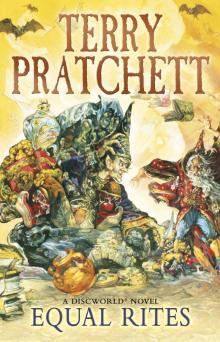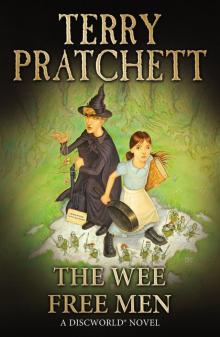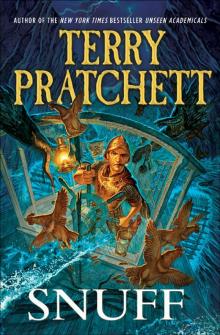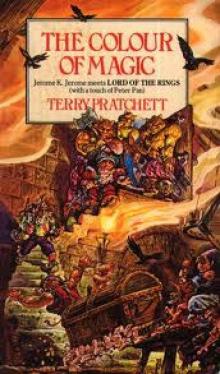- Home
- Terry Pratchett
The Folklore of Discworld Page 10
The Folklore of Discworld Read online
Page 10
‘And cut their head off?’
‘Apparently you don’t have to.’ [Carpe Jugulum]
Decapitation was the folk method in parts of Europe too, especially among Germans and western Slavs, with the addition that the severed head must be placed between the legs of the corpse, behind its buttocks, or below its feet – so that it couldn’t find it and put it back on. The southern Slavs preferred staking the corpse; Greeks cremated it, often cutting the heart out first; Russians would throw it into a lake or river. Danes staked revenants; medieval Icelanders beheaded and/or burned them.
There was no need to stick to one method at a time. In Germany, one woman who ‘walked’ was dug up, decapitated, and then reburied at a crossroads with her mouth full of poppy seeds. Another corpse was taken to a border between two districts, cut open, staked through the heart, and beheaded; a stone was put in the mouth, and both body and head were left lying there, for animals to eat.
Of course, it was best if you could stop the corpse from leaving its grave at all, by giving it something to do which would keep it there. For example, Oats told Nanny Ogg, you can defeat vampires by stealing their sock:
‘They’re pathologically meticulous, you see. Some of the gypsy tribes in Borogravia say that if you steal their sock and hide it somewhere they’ll spend the rest of eternity looking for it. They can’t abide things to be out of place or missing … They say in some villages that you can even slow them down by throwing poppyseed at them. Then they’ll have a terrible urge to count every seed. Vampires are very anal-retentive, you see?’
Paul Barber, a notable American authority on vampires, has similarly stressed their ‘limited, rigid, and compulsive nature’. This makes it easier to stop them from coming home after burial. For instance, they have to re-enter the house in the same way they left it, so if you lift the coffin out through a window or a hole in the wall, instead of using the door, and then shut the window or refill the hole, they’ll never find the way back. If you bury them face down, when they try to dig themselves out they’ll just go down deeper and deeper. If you put seeds or sand in a vampire’s mouth or coffin, or on the path to the graveyard, this activates his compulsions: ‘he must collect the grains one at a time, and often only one grain per year. This so engages his attention that he is obliged to drop all other pursuits.’ Nets and knitted stockings in the coffin are just as good; he has to unpick them, one knot or stitch per year. As for putting coins, pebbles, dirt or food in the corpse’s mouth, that gives him something satisfying to chew on.
So a girl setting out to be a vampire-slayer in Uberwald needs a big sack, to be ready for all possibilities. She must carry a stake and mallet, a spade, and a strong knife; nets, seeds, coins, sand, salt, stones, lemons, garlic, assorted vegetables; thorns and needles to stick in the vampire’s feet to stop him walking, and in his tongue to stop him sucking; a flask of holy water and the sacred symbols of all major gods.
But, as Nanny Ogg could tell her, there is a better way. She could simply borrow Greebo the cat, and wait till a very large red-eyed bat comes by. For that would be a flabberghast (‘which is foreign for bat,’ Nanny Ogg explains), and a flabberghast is a shape-shifted vampire. And it would very soon learn the useful truth set down in Witches Abroad:
Vampires have risen from the dead, the grave and the crypt, but have never managed it from the cat.
BANSHEES
These unpleasant (and mercifully rare) creatures, native to the Uberwald mountains, are the only humanoid species on the Discworld that has evolved wings, apart from certain small elves; vampires who fly, such as the Count de Magpyr and his family, simply do so by a form of levitation. However, there may possibly be some remote genetic connection between the two races, since a banshee has two hearts, which, according to some folk traditions, is a characteristic of vampires. No research has been done on this topic, nor is likely to be.
A Discworld banshee is about the same size as a man, but far more lightly built, consisting almost entirely of thin bones and very strong sinews, several rows of pointy teeth, and huge claws. At first glance, you would think it is wearing a black leather cloak. This, as you will soon discover, is its wings. And then there is its scream.
It was harsh, guttural, it was malice and hunger given a voice. Small huddling shrew-like creatures had once heard sounds like that, circling over the swamps. [Going Postal]
It is well known that to hear the banshee’s scream means that you are going to die. With the more civilized banshees, all this means is that they have taken on the job of a death-omen, and will sit screeching on your roof to make sure you get plenty of warning that Death is on his way. Indeed, in Ankh-Morpork there is one solitary and gloomy banshee named Ixolite who suffers from a speech impediment and just writes OoooEeeeOoooEEEeee on a scrap of paper and slips it under your door. But the wild banshees, such as the Mr Gryle described in Going Postal, do the whole job themselves. One minute you hear the scream, next minute there’s a swoop and a pounce and some quite remarkable claws.
Over in our own parallel universe, banshees are only to be found in one particular habitat, namely Ireland. The name, if not the species, must have originated there, since bean sí makes good sense in Irish, though it is mere gibberish in Discworld languages. It means ‘woman of the otherworld’ – for in Ireland the creature is invariably female. Her mission is to announce the imminent death of someone in one of the old aristocratic Irish families, by screaming and wailing near their homes. She is more often heard than seen, but when she does let herself be glimpsed it is as an old woman with long, loose white hair which she combs as she wails. Sometimes she is seen crouching by a river, washing a winding-sheet. In some parts of the country she is also known as the badhbh chaointe, pronounced ‘boheenta’ and meaning ‘the keening scaldcrow’, though she does not nowadays actually appear in crow-shape.
Though the Irish banshee is no predator, it is best to be wary of offending her. There was once a man who saw a banshee combing her hair on the riverbank at twilight, crept up behind her, and snatched her comb. He ran home with it. That night there were terrifying shrieks all around his house, and something was hammering on his window. So he opened the window just a little way and pushed the comb out, holding it in the big iron tongs from the fireplace. And it was well for him that he did so rather than putting his hand out, for the thing that grabbed the comb grabbed the tongs too and threw them to the ground, all bent and twisted. Such is a banshee’s strength.
GOLEMS
In all societies there is a good deal of boring, dirty, heavy work which nobody really wants to do, whatever the pay. So what could be better than to find a race of strong, tireless, silent workers to take on these jobs? Especially if they don’t need paying.
The historical solution, in Ankh-Morpork, is the golems – large, powerful creatures made of baked clay, roughly humanoid in form but seven or eight foot tall. They need no food or sleep; they can work underwater, or in extremes of heat or cold, or in total darkness; they cannot feel pain or boredom. They can repair themselves, and last for centuries. Their triangular eyes have the faint, dark red glow of a banked fire, and on the rare occasions when they open their mouths you get a brief glimpse of an inferno. According to the original specifications they cannot speak, though they can write; this, however, was changed at the insistence of Commander Vimes, after the events recounted in Feet of Clay.
A golem’s head is hollow, and flips open when you press a line across the forehead; inside is a yellowing scroll bearing words in Cenotine, an ancient sacred script, the language of a dead religion. This has to have been written by a priest. Take out the scroll, and the light in the golem’s eyes goes out, and its life (if it can be called life) ceases. Put it back, and it comes ‘alive’ again. When the golem Dorfl is asked to explain itself, it writes on a slate:
I am a golem. I was made of clay. My life is the words. By means of words of purpose in my head I acquire life. My life is to work. I obey all commands. I take no rest … G
olem must work. Golem must have a master. [Feet of Clay]
The written commands in a golem’s head are those which the Cenotine god is said to have given to the first people on earth, after he had baked them out of clay. ‘Thou shalt labour fruitfully all the days of your life’ is one of them, and another is ‘Thou shalt not kill’, and a third ‘Thou shalt be humble’.
Not surprisingly, factory owners are prepared to pay a good price for golems. There are stories that sometimes one of them over-does things, being too stupid to stop work unless actually ordered to, so your house gets flooded as it brings pail after pail from the well. This, however, always seems to have happened somewhere else, some good while ago, and can be disregarded. One minor snag is that just occasionally they down tools and go off for a few hours, leaving a message that today is for them a holy day. Apart from that, they are perfect machines for work.
Few in Ankh-Morpork remember who first made a golem, or why, or how. Recent archaeological discoveries (described in Making Money) indicate that particularly fine specimens existed in the ancient City of Um, back in the Clay Age some sixty thousand years ago. When Rincewind visited the Counterweight Continent (see Interesting Times) he accidentally roused a vast Red Army of seven thousand terracotta golems, which were standing guard inside the burial mound of some very ancient emperor – but again, nothing is known of their making. To learn more, one must turn to the more recent traditions of Jewish communities in Central and Eastern Europe. For there, by one of those remarkable freaks of cosmic resonance, the story of the making of the golem first appeared in fifteenth-century Germany, and by the seventeenth century had become famous.
In Hebrew, the word ‘golem’ means an unshaped lump of matter, an imperfect or incomplete creation. According to legend, various extremely learned and pious rabbis knew how to create a humanoid being out of clay, thanks to the magical power of holy words and letters, especially the four letters forming the Name of God. The act echoed that of God Himself in forming Adam from the dust of the earth, and for that reason most rabbis never put their knowledge into practice, for fear of blasphemy. But a few did, to get themselves a servant, or to get help in times of great danger.
The fullest and most famous story is about Judah Loew ben Bazalel, Chief Rabbi of Prague towards the end of the sixteenth century. In 1580 the Jews of Prague were under attack from anti-Semitic fanatics, and Rabbi Loew received a divine message telling him to create a golem for their protection. Four elements would be required: earth, fire, water and air. He went with two disciples to the bank of the River Vltva, and moulded a human form of clay. Then one disciple danced round it seven times from right to left, saying certain words which invoked the element of fire, causing it to glow like red-hot metal. The other disciple danced round it seven times from left to right, saying words to invoke the element of water, and by the time he had finished steam was rising, and the golem’s hair and nails had begun to grow. Finally Rabbi Loew himself danced round seven times, breathed air into the golem’s nostrils, and put a parchment with a word on it into its mouth – or, some say, wrote a word upon its brow.
Then the golem came to life and stood up, though it lacked the power of speech. Rabbi Loew said: ‘Your mission is to walk the streets of Prague and keep my people safe from persecution. You will obey my commands, and go wherever I send you – into fire, into water, or down to the floor of the sea.’
What was the word that gave a golem life? Some say it was schem, which means ‘name’, and refers to the Tetragrammaton JHVH, the never-to-be-spoken Holy Name of God. Others say it was emeth, ‘truth’, and that one could destroy the golem by rubbing out the first letter, leaving meth, which means ‘death’. For eventually, all legends agree, something will go wrong, and the golem will have to be ‘killed’. Perhaps it has grown so big and powerful that its maker can no longer control it. Or perhaps he has forgotten to give it its orders for the day, and it has gone berserk through having nothing to do, and is about to devastate the city.
In Prague, Rabbi Loew kept his golem till 1593, but then, knowing the danger of persecution had passed, he and his disciples reversed their rituals, reducing it to a mere mass of clay. This they sealed up in the attic of the Synagogue, and Rabbi Loew ordered that nobody was ever to set foot in that attic again. And nobody ever has.
Such was the sad destiny of Earth’s golems. In the Discworld, thanks to the ferocious sense of justice of Commander Vimes and the pragmatism of Lord Vetinari, golems are now in process of buying their freedom from their masters, and have acquired speech and independence of thought. The words in their heads are those they have chosen themselves. Still untiring and sternly moral, some have found a role as law enforcers (one instance of this is described in Going Postal). Naturally, this requires a certain modification of one of the basic Laws of Golems, which now runs: ‘You shall not harm a human being, or allow a human being to come to harm – unless ordered to do so by a properly constituted authority.’ As we have said, Lord Vetinari is a pragmatic ruler. That is not the same as nice.
WEREWOLVES
Wherever wolves are found in the multiverse, there are werewolves too, yet the condition of werewolfery (or lycanthropy, as those of more scientific bent prefer to call it) remains mysterious. What can be the cause? Is it voluntary or involuntary? Is it a magical power, or a form of madness? Are werewolves heroes, victims, or criminals?
The clash of theories is obvious on Earth. Several Ancient Greek writers blamed religious cannibalism, allegedly practised in honour of Lycean (i.e. ‘Wolfish’) Zeus in the wild hilly region of Arcadia. According to Pausanias, a Greek geographer writing in AD 166, the first werewolf was a certain King Lycaon of Arcadia, whose very name means ‘wolf’.
Lycaon brought a human baby to the altar of Lycean Zeus and sacrificed it and poured out the blood upon the altar, and they say that immediately after the sacrifice he was turned into a wolf. For my own part I believe the tale: it has been handed down among the Arcadians from antiquity, and probability is in its favour. They say that from the time of Lycaon downwards one man has always been turned into a wolf at the festival of Lycean Zeus, but that the transformation is not for life, for if while he is a wolf he abstains from human flesh, in the ninth year afterwards he changes back into a man, but if he has tasted human flesh he remains a beast for ever.
About a hundred years earlier, the Roman author Petronius had included a werewolf story, more or less as a joke, in his comic novel Satyricon. To him, it was simply magical shape-shifting: a young soldier deliberately turned into a wolf by taking off his clothes in a graveyard by moonlight and pissing round them, and went off to kill cattle and sheep – but then, like many shape-shifters before and since, he was wounded while in animal form, and so his secret was discovered.
In later European folklore, all sorts of explanations were suggested. Some said it was a magic art of warriors, who went into battle as wolves by wearing a wolf’s pelt. Others, that it was due to a spell which a witch could lay on a man by striking him with a wolfskin glove. Others, that it came from accidentally eating a particular magic plant, or bathing in a particular lake. Others, that it was a curse that a child was born with, as a punishment because his parents conceived him on a holy day when sex was not allowed,8 or because his mother used magic to avoid a painful childbirth. Others, that the man had made a deliberate pact with the Devil, and went about murdering people while in his wolf form. In more recent centuries, it has been generally assumed that lycanthropy was a madman’s delusion. Attitudes varied according to the theories – wolf-warriors were admired as heroes, the victims of spells and curses were to be pitied as well as feared, the lunatics were to be locked up, but murderous Satanist werewolves were to be tried and hanged.
There are no such crazy notions on the Discworld. There, everybody knows that being a werewolf is just something that you’re born with, something that runs in families. It’s not supernatural, but it’s very, very embarrassing. Especially if you live in a town. Most humans
and dwarfs find werewolves both frightening and disgusting, so werewolves do all they can to keep their condition secret, and most of the time they can pass as human. But if when in wolf shape they were to meet real wolves, they could never pass as wolf – the scent is quite different. And for the most part real wolves detest werewolves. So, one way and another, werewolves lead a lonely life.
The genetic laws governing Discworld werewolfery are logical, but far more complex than the transformation rules of Earth, since the condition can show itself in different forms. Ludmilla Cake, who is a ‘classic bimorph’ werewolf, is a tall, strong girl for three weeks in every month, though a careful observer might note that her hair is unusually thick and long. In the week of the full moon, however, she becomes a wolf and stays in her room, so as not to upset the neighbours. Sometimes preliminary signs appear a day or two before what her mother coyly refers to as ‘your Time’:
Something came in from the back yard. It was clearly, even attractively female in general shape, and wore a perfectly ordinary dress. It was also apparently suffering from a case of superfluous hair that not all the delicate pink razors in the world could erase. Also, teeth and fingernails were being worn long this season. You expected the whole thing to growl, but it spoke in a pleasant and definitely human voice. [Reaper Man]
Mrs Cake’s forebears had originally come from the Ramtop Mountains, and she suspected that Ludmilla was a throwback to this distant past; she was pretty sure that her own mother had once alluded circumspectly to a Great-Uncle Erasmus who sometimes had to eat his meals under the table.
The exact opposite of a werewolf is a wolfman. For three weeks in every month he is simply a wolf, but as soon as he sees the full moon he stops howling, most of his hair temporarily falls out, and next minute he’s standing up, walking and talking. The problem is, no clothes. So when the full moon is due to rise, a canny wolfman takes care to get back to where he keeps a pair of trousers stashed. It is to be hoped that Lupine the Wolfman and Ludmilla the Werewolf have managed to find happiness together, despite having to pay more attention to the calendar than most couples.

 Feet of Clay
Feet of Clay The Color of Magic
The Color of Magic Thud!
Thud! Good Omens: The Nice and Accurate Prophecies of Agnes Nutter, Witch
Good Omens: The Nice and Accurate Prophecies of Agnes Nutter, Witch I Shall Wear Midnight
I Shall Wear Midnight Mort
Mort Raising Steam
Raising Steam Guards! Guards!
Guards! Guards! Equal Rites
Equal Rites A Hat Full of Sky
A Hat Full of Sky The Light Fantastic
The Light Fantastic Mrs Bradshaw's Handbook
Mrs Bradshaw's Handbook Wyrd Sisters
Wyrd Sisters Soul Music
Soul Music Small Gods
Small Gods Sourcery
Sourcery Reaper Man
Reaper Man Night Watch
Night Watch Lords and Ladies
Lords and Ladies The Fifth Elephant
The Fifth Elephant Monstrous Regiment
Monstrous Regiment The Truth
The Truth Witches Abroad
Witches Abroad Eric
Eric Going Postal
Going Postal Men at Arms
Men at Arms Jingo
Jingo The Amazing Maurice and His Educated Rodents
The Amazing Maurice and His Educated Rodents The Wee Free Men
The Wee Free Men Pyramids
Pyramids Wintersmith
Wintersmith Moving Pictures
Moving Pictures Carpe Jugulum
Carpe Jugulum Interesting Times
Interesting Times Maskerade
Maskerade Making Money
Making Money The Shepherd's Crown
The Shepherd's Crown Hogfather
Hogfather Troll Bridge
Troll Bridge The Last Continent
The Last Continent The Sea and Little Fishes
The Sea and Little Fishes Snuff
Snuff Unseen Academicals
Unseen Academicals Guards! Guards! tds-8
Guards! Guards! tds-8 Jingo d-21
Jingo d-21 Turtle Recall: The Discworld Companion ... So Far
Turtle Recall: The Discworld Companion ... So Far The Fifth Elephant d-24
The Fifth Elephant d-24 Discworld 39 - Snuff
Discworld 39 - Snuff The Long War
The Long War Only You Can Save Mankind
Only You Can Save Mankind The Science of Discworld III - Darwin's Watch tsod-3
The Science of Discworld III - Darwin's Watch tsod-3 A Blink of the Screen: Collected Short Fiction
A Blink of the Screen: Collected Short Fiction Unseen Academicals d-37
Unseen Academicals d-37 Wings
Wings Making Money d-36
Making Money d-36 A Blink of the Screen
A Blink of the Screen Johnny and the Bomb
Johnny and the Bomb Dodger
Dodger Strata
Strata Discworld 02 - The Light Fantastic
Discworld 02 - The Light Fantastic The Folklore of Discworld
The Folklore of Discworld The Science of Discworld
The Science of Discworld The Unadulterated Cat
The Unadulterated Cat Raising Steam: (Discworld novel 40) (Discworld Novels)
Raising Steam: (Discworld novel 40) (Discworld Novels) The World of Poo
The World of Poo Discworld 05 - Sourcery
Discworld 05 - Sourcery The Witch's Vacuum Cleaner: And Other Stories
The Witch's Vacuum Cleaner: And Other Stories The Science of Discworld II - The Globe tsod-2
The Science of Discworld II - The Globe tsod-2 Small Gods: Discworld Novel, A
Small Gods: Discworld Novel, A Men at Arms tds-15
Men at Arms tds-15 Tama Princes of Mercury
Tama Princes of Mercury The Last Hero (the discworld series)
The Last Hero (the discworld series) The Long Utopia
The Long Utopia Discworld 03 - Equal Rites
Discworld 03 - Equal Rites Terry Pratchett - The Science of Discworld
Terry Pratchett - The Science of Discworld The Long Earth
The Long Earth The Carpet People
The Carpet People The Sea and Little Fishes (discworld)
The Sea and Little Fishes (discworld) The Colour of Magic
The Colour of Magic Discworld 16 - Soul Music
Discworld 16 - Soul Music The Long Cosmos
The Long Cosmos The Dark Side of the Sun
The Dark Side of the Sun Monstrous Regiment tds-28
Monstrous Regiment tds-28 The Bromeliad 3 - Wings
The Bromeliad 3 - Wings Dragons at Crumbling Castle: And Other Stories
Dragons at Crumbling Castle: And Other Stories Night Watch tds-27
Night Watch tds-27 The Science of Discworld I tsod-1
The Science of Discworld I tsod-1 The Bromeliad 1 - Truckers
The Bromeliad 1 - Truckers The Science of Discworld Revised Edition
The Science of Discworld Revised Edition The Abominable Snowman
The Abominable Snowman Father Christmas’s Fake Beard
Father Christmas’s Fake Beard The Bromeliad Trilogy
The Bromeliad Trilogy A Slip of the Keyboard
A Slip of the Keyboard The Wee Free Men d(-2
The Wee Free Men d(-2 Johnny and the Dead
Johnny and the Dead Mrs Bradshaw's Handbook (Discworld Novels)
Mrs Bradshaw's Handbook (Discworld Novels) Truckers
Truckers The Amazing Maurice and His Educated Rodents d(-1
The Amazing Maurice and His Educated Rodents d(-1 Diggers
Diggers Thief of Time tds-26
Thief of Time tds-26 Science of Discworld III
Science of Discworld III Dragons at Crumbling Castle
Dragons at Crumbling Castle Nation
Nation Darwin's Watch
Darwin's Watch Interesting Times d-17
Interesting Times d-17 The Bromeliad 2 - Diggers
The Bromeliad 2 - Diggers The Science of Discworld II
The Science of Discworld II